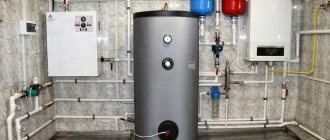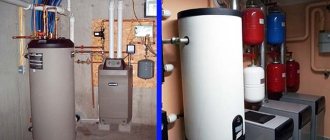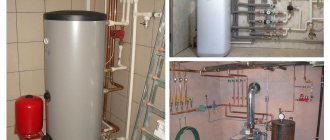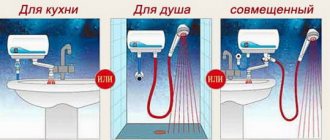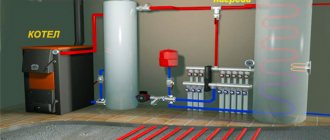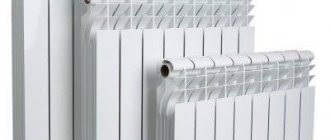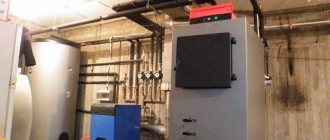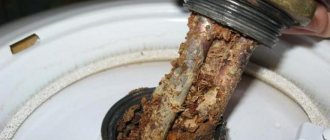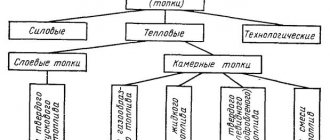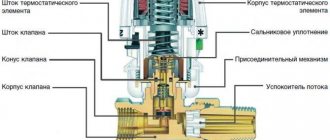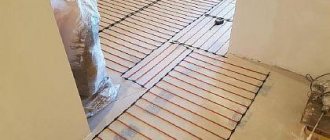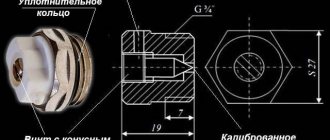Principle of operation
The heart of any home is the heating boiler. During the cold season, it provides the home with warmth. Among the variety of models of heating equipment, two-circuit devices that heat the coolant and water in the hot water system are often distinguished. But when you turn on the tap, the equipment stops heating the rooms and directs all its energy to heating water. This is why using hot water for a long time can cause the house to freeze.
An example of connecting a double-circuit boiler Source otoplenie-gid.ru
It is much more economical and efficient to connect a water heater to the heating boiler. The operating principle of an indirect heating boiler is very simple: the equipment uses coolant energy to heat water. It is connected to the heating boiler, but when the water is turned on, even in several taps, the heating of the house does not stop. The equipment is a tank, inside of which there is a spiral-shaped tube (coil). The coolant flows through it, heating the water.
To understand what an indirect heating boiler is and what it is needed for, you need to imagine a large water tank with a tube located inside. The walls are equipped with a layer of insulation. Thanks to this, the water always remains warm. With such equipment, owners will be able to use hot water at any time.
A minimum amount of energy is spent to maintain the temperature of the liquid: the flow of heated coolant is divided: the first part is supplied to the coil, and the second to the heating system. The waste liquid is returned to the boiler for further heating. Installing an indirect heating boiler only slightly increases fuel consumption.
Connection diagram for an indirect heating boiler Source oteple.com
Features of indirect heating boiler piping
It is easier to do the wiring and piping if the KN boiler is installed together with a boiler, pumps and other equipment involved in the assembly of the hot water supply system. It is much more difficult to insert an additional device into an existing network.
In any case, for normal operation of the devices you will have to follow a number of rules:
- choose the right installation location - as close to the boiler as possible;
- provide a flat surface for mounting the boiler;
- to protect against thermal expansion, install a membrane hydraulic accumulator (at the heated water outlet), the volume of which is at least 1/10 of the volume of the BKN;
- equip each circuit with a ball valve - for convenient and safe maintenance of devices (for example, a three-way valve, pump or the boiler itself);
- to protect against backflow, install check valves on the water supply pipes;
- improve water quality by installing filters;
- correctly position the pump (or several pumps) - the motor axis must be in a horizontal position.
For safety reasons, do not attempt to secure heavy devices to plasterboard or thin wood partitions. Walls made of concrete and brick are suitable. Brackets or other types of holders are secured with brackets, anchors, and dowels.
Regardless of the type of device - floor-mounted or wall-mounted - if possible, it should be mounted above the level at which the boiler is installed, or at the same level. For the floor, you can make a pedestal or a durable stand up to 1 m high
When installing, the pipes are directed towards the boiler (even if they are masked in the back or behind a false wall). Do not use unreliable equipment, such as corrugated hoses that cannot withstand pressure and water pressure.
For normal operation of an indirect heating storage water heater, the following functional devices must be included in the piping:
- A complex technical system must be equipped with pumps that supply hot sanitary water to the taps and stimulate the movement of coolant along the heating branch, as well as along the water heating circuit in the boiler
- Before being supplied to the boiler, cold water coming from a public or independent water supply must be purified through a mud filter or a filter system that destroys lime salts. Filtration will prevent the formation of mineral deposits
- After the sump tank or water filtration system there should be a pressure reducer. However, it is only needed if the pressure in the branch exceeds 6 bar
- A check valve is required before cold water enters the boiler to prevent reverse flow.
- In order for the heating water to have a reserve for expansion during the period when it is not used, an expansion tank and a safety valve to relieve pressure are included in the piping
- To prevent excessively hot water from flowing into the taps, which can cause burns, a three-way mixing valve must be installed in the circuit. It will mix portions of cold water with hot water, and as a result, the tap will contain water at the temperature required by the user.
- To ensure that the coolant from the heating flows into the “jacket” that heats the sanitary water only when it is needed, a two-way thermostat is installed. Its server connects to the water heater temperature sensor
- If the consumption of hot water in the house is high enough, it is advisable to purchase a boiler with a built-in additional instantaneous water heater or buy a separate device and include it in the hot water supply line. If there is a shortage of it, a miniature flower will come into operation and save the situation.
What pipes are suitable for piping
To connect the boiler and heating wiring, it is better to take metal-plastic or polypropylene pipes. They will cost less than galvanized or copper counterparts.
Consistent wiring of radiators is carried out using metal-plastic pipes on press fittings or polypropylene pipes with aluminum reinforcement. However, each of these options has its own drawback. Press fittings are sensitive to the quality of installation and leakage may occur at the slightest displacement. Polypropylene has a high elongation coefficient when heated to more than 50°C. For wiring the “warm floor” system, metal-plastic with press fittings, polyethylene or thermally modified polyethylene are used.
Advantages
An indirect heating water heater is a common equipment for country houses. Its popularity is due to several advantages:
- efficiency;
- constant maintenance of high water temperature;
- heating a large volume of liquid in a short time;
- possibility of connecting several water intake points;
- if necessary, several heat sources are connected;
- work with any heating boilers.
An indirect heating boiler is a universal equipment; it can be connected to any heating boiler (solid fuel, electric, gas, combined). In this case, the coolant does not come into contact with the heated liquid. Some people exchange water for a non-freezing liquid - antifreeze. This allows you to leave the house without heating during the cold season and are not afraid of freezing and cracking of pipes.
Attention! Antifreeze in the system poses a great danger to people. If there is a small crack in the coil, toxic liquid enters the water supply system. This can lead to poisoning of people. You can use propylene glycol, which is practically safe for health. But getting it into water can also cause unpleasant consequences.
Internal structure of a water heater Source teplogalaxy.ru
See also: Catalog of companies that specialize in the installation of utilities: water supply, heating and sewerage
Flaws
Before equipping your home with a hot water supply system, you need to learn as much as possible about the indirect heating boiler: what it is, how it works, what disadvantages it has. A water heater operating in conjunction with a heating boiler has few disadvantages:
- The cost of the equipment is high, so owners need to prepare for significant expenses before installing the system.
- During the warm season, the heating boiler stops functioning, which means water heating stops. Owners need to find an alternative source of hot water.
- Water heaters have a large water capacity and impressive dimensions, so they will require a spacious room to accommodate them.
To provide people with hot water even when the heating system is turned off, manufacturers have developed a tank with a tubular electric heater (TEN). It can heat water in warm seasons.
Indirect heating boiler with heating element Source biysk.kotel-t.ru
How does an indirect heater work?
There is a hollow spiral in the tank. A coolant circulates inside, which distributes heat throughout the system. Its constant movement is ensured by a circulation pump. As soon as the thermometer registers that the specified temperature has been reached, the pump automatically turns off. Thanks to the thermal insulation layer, heat loss during shutdown is only 3-4 degrees per day.
Inlet and outlet pipes are connected to the tank, through which hot water flows into the boiler.
Scheme of work:
What to look for when choosing:
- Power . It must correspond to the parameters of the heating system. Otherwise, the system may not be able to cope with the load or, conversely, the power will not be enough for normal heating.
- Accommodation . If the heating boiler is placed on the floor, then it is better to choose a floor-standing boiler. In other cases, give preference to wall-mounted ones.
Experts recommend purchasing a boiler and a boiler of the same brand. Then installation and connection will be easy and smooth.
- Heat exchanger flow . The values are indicated in the technical documents. Ideally, the figure should not exceed 40% of the total volume of liquid in the tank.
Read how to make an indirect heating boiler in a separate publication.
How to choose
The combined operation of a heating boiler and an indirect heating boiler ensures rapid heating of water at minimal cost. But you can benefit from installing such equipment only if you select the right water heater.
The main criterion for choosing equipment is the volume of the tank. It depends on the number of people taking showers and on the number of water intake points. All schemes for determining the volume of the tank are designed for the average resident of a private house. When selecting equipment, it is necessary to analyze the habits of household members and only then find the best option.
Scheme for choosing the volume of a water heater for a house or apartment Source cs11.pikabu.ru
Another important selection criterion is the material used to make the coil and the tank itself. The most efficient heating element is made of brass. It has high thermal conductivity and quickly heats water.
When producing a tank, it is necessary to ensure that the metal is protected from corrosion. The interior of inexpensive tanks is coated with enamel. But such a protective layer is vulnerable; it can deteriorate over time. Durable tanks are made of stainless steel.
Stainless steel tank with copper heating element Source i.ytimg.com
Water heater design
The market offers products of various shapes, volumes and technical characteristics. Regardless of this, each individual type of water heater is similar in design.
Electric storage
By its design, a product of this type is a round or oval-shaped container. The tank is used to accumulate and heat water.
It is housed in a housing made of metal or plastic. To avoid rapid cooling of the liquid, manufacturers equip the container with a thermal insulation layer. The tank is made from materials that are least susceptible to corrosion. There are products on the market whose containers are made of enameled or stainless steel. To protect internal parts from scale formation, water heaters are equipped with a magnesium anode.
Operation of an electric storage heater
At the bottom there is an electric heater. It is equipped with a thermostat that allows you to maintain a certain temperature of the liquid. Some models have two heating elements installed.
After heating the liquid, one of them turns off, and a certain temperature is maintained by the other. This allows you to save energy. The boiler device includes two pipes. They are used to supply water and remove it from the tank. The cold water pipe is installed at the bottom of the tank, and the hot liquid collection tube is installed at the top.
Electric flow
The instantaneous boiler device for heating water does not include a storage tank. The liquid warms up as it passes through the device. Heating is carried out by a high power electric heater.
The design features of the flow-type product allow you to quickly warm up a small amount of water. The design of the flow-type product includes:
- High power electric water heater.
- Operation indicator.
- Shirt for water passage.
- Sensors and relays.
Flow-through boiler. Photo source: rgagroup.ru
Due to the absence of a storage tank, instantaneous boilers are small in size. This makes it possible to install the device in rooms with limited free space.
Gas water heaters
Devices using gas as a heat source can be either flow-through or storage type. Instantaneous water heaters - geysers can quickly warm up a small amount of liquid passing through them.
Using storage tanks you can get a large amount of hot water, but after that it will take time to warm up a new portion. Storage devices consist of a metal tank through which a gas duct passes. It is necessary to remove gas combustion products. Instead of a heating element, the water heater uses a gas burner. The degree of heating is controlled by a specialized unit.
Connection diagram
Connecting an indirect heating boiler to a single-circuit boiler of any type is carried out according to the same schemes: with or without priority. In the first case, the coolant, if necessary, changes the direction of movement and stops heating the house, and all the energy of the boiler is directed to heating. This method allows you to quickly heat a large volume of water.
At the same time, heating of the house is stopped. But a boiler, unlike a double-circuit boiler, heats the water for a short time and the rooms do not have time to cool down.
Features of connecting an indirect heating boiler depend on the pipe material:
- polypropylene;
- metal-plastic;
- steel.
The easiest way is to connect the equipment to polypropylene communications that are not sewn into the walls. In this case, the technician will have to cut the pipe, install tees, and use couplings to connect the pipes going to the boiler.
To connect to hidden polypropylene communications, it is necessary to additionally install pipes going to the pipes in the walls.
There is no technology for concealed installation of metal-plastic water supply systems, so the connection will be identical to the connection of polypropylene open communications.
Correctly installed indirect heating boiler Source www.o-vannoy.ru
Video description
Connecting the boiler in the video:
When installing a water heater, you must first choose the right location in accordance with the requirements:
- Quick access to water supply connections for quick repair work.
- Proximity of communications.
- Availability of a strong load-bearing wall for mounting wall-mounted models. In this case, the distance from the fasteners to the ceiling should be 15–20 cm.
Options for placing a water heater Source legkovmeste.ru
What is a boiler?
A boiler as :
- a functional element of the boiler, which is a container in which the coolant (most often hot water) is temporarily accumulated (before serving to the consumer);
- a device designed for autonomous (without using a boiler as the main unit) heating of the coolant (again, as a rule, hot water).
The boiler in the first interpretation has 2 key consumer characteristics:
- capacity;
- throughput (the rate of supply of a particular volume of coolant to the consumer).
For a boiler in the second interpretation, these characteristics can be supplemented with almost the same characteristics as those characteristic of a boiler, since the unit in question will be its analogue in terms of functionality.
Possible mistakes
When connecting an indirect heating boiler, people make several common mistakes:
- The main mistake is the incorrect placement of the water heater in the house. The device installed far from the heat source requires pipes to be laid to it. This leads to increased costs. At the same time, the coolant going to the boiler cools in the pipeline.
- Incorrect connection of the cold water outlet will reduce the efficiency of the device. It is optimal to place the coolant inlet at the top of the device, and the outlet at the bottom.
To increase the service life of the system, it is necessary to correctly connect and then perform periodic maintenance of the equipment. It is important to clean the pump and maintain its performance.
Option for correct placement and connection of a water heater Source opt-953360.ssl.1c-bitrix-cdn.ru
Briefly about the main thing
An indirect heating boiler is an economical way to organize a hot water supply system at home. The equipment uses the energy of the heating boiler for heating, this does not lead to additional costs.
A water heater is a long-lasting piece of equipment, so you should choose a quality unit. Stainless steel tanks with a brass coil performed best. They quickly heat water and are not afraid of corrosion.
Ratings 0
